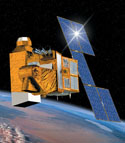European Nations Focus Space-Based Observation Capabilities
 |
| The Multinational Space-based Imaging System (MUSIS) will provide a consortium of five European nations with next-generation satellite imaging capabilities and the ability to process and share data rapidly. MUSIS will replace current platforms such as the Helios family of observation satellites, which are scheduled to reach the end of their operational lives beginning in 2014. |
A proposed constellation of reconnaissance satellites soon may allow European governments to acquire and share satellite imagery rapidly. The multinational effort seeks to launch a new generation of imaging spacecraft to replace aging platforms. The program will permit participating nations to access individual satellites and sensors to meet their intelligence requirements.
The goal of the Multinational Space-based Imaging System (MUSIS) project is to develop a successor system to the current generation of European imaging satellites. The new system will consist of a constellation of military and dual-use spacecraft equipped with optical, infrared, radar and hyperspectral sensors. MUSIS will replace national platforms such as
Stephane Roget, the MUSIS project’s French architect, Bagneux, France, notes that the program is currently defining the best satellite types for providing imagery to theater commanders through a pilot effort to connect expeditionary naval units. Requests are uplinked directly from warships to the nearest orbiting spacecraft. The goal is for the satellite to transmit the requested images to a processing center then back to commanders within hours. This process currently takes several days. “The idea is to decrease this delay with respect to what we have today,” he says.
Developed by a multinational consortium consisting of
The new constellation will consist of a variety of satellites, each with its own specialized sensor. Roget notes that the current European satellite program plans to have a 13-spacecraft constellation in orbit by 2010. However, many of these spacecraft will begin to reach the end of their operational lives in the 2014 to 2017 time period. The proposed MUSIS constellation will replace these orbiting platforms and will consist of 10 or more satellites launched between 2014 and 2015. However, he cautions that discussions are still underway to develop the best architecture to meet common operational needs.
MUSIS satellites will use next-generation technologies such as hyperspectral sensors capable of detecting hidden ground targets. Roget emphasizes that the exact structure of the satellites has not been fully determined, adding that as new technologies become available, they will be integrated into the system.
The capability to process and share imagery among several nations will form the core of a future information system that has a data-sharing architecture that allows users to access different types of imagery selectively. Roget speculates that it may be possible for commanders in forward command centers to order data from the constellation directly from their battlefield computers. “The satellites that we foresee are very agile. It means that they can point [their sensors] at many places inside the theater,” he says.
As the lead nation in the MUSIS consortium,
The system’s architecture will allow consortium nations to coordinate imaging requests at the national and international levels. The two aerospace teams are currently defining the MUSIS ground segment and its internal and external interfaces. The ground segment will provide services such as imagery request management, mission planning, image production, archiving, cataloging, image distribution, administration and security management. The teams also are responsible for defining project elements such as the program’s operational, technical, financial and scheduling characteristics.
Besides designing a ground support system, its architecture and interfaces with the spacecraft, the two industry teams are required to apply lessons learned from the development of current imaging spacecraft such as Helios and SAR-Lupe.
Requests for MUSIS imagery will be managed through a central facility in
MUSIS imagery will be shared among the consortium nations, but no plans have been made yet for providing data to the European Union or NATO command chains. Roget notes that other European nations can join the multinational group, although he adds that the exact framework for international cooperation is still being negotiated.
The five-nation consortium also is responsible for developing, managing and sharing data from the Helios family of reconnaissance satellites. The latest generation of Helios II observation spacecraft now entering service is designed to provide continuity of service while offering improved capabilities such as enhanced image resolution, infrared capability, expanded imaging capacity, simultaneous operation in a number of modes and reduced image transmission times. The Helios II spacecraft will be used for targeting, guidance, mission planning and battle damage verification.
Web Resources
French Ministry of Defense (MOD): www.defense.gouv.fr
French MOD Armaments Portal: www.ixarm.com/index_en




Comments